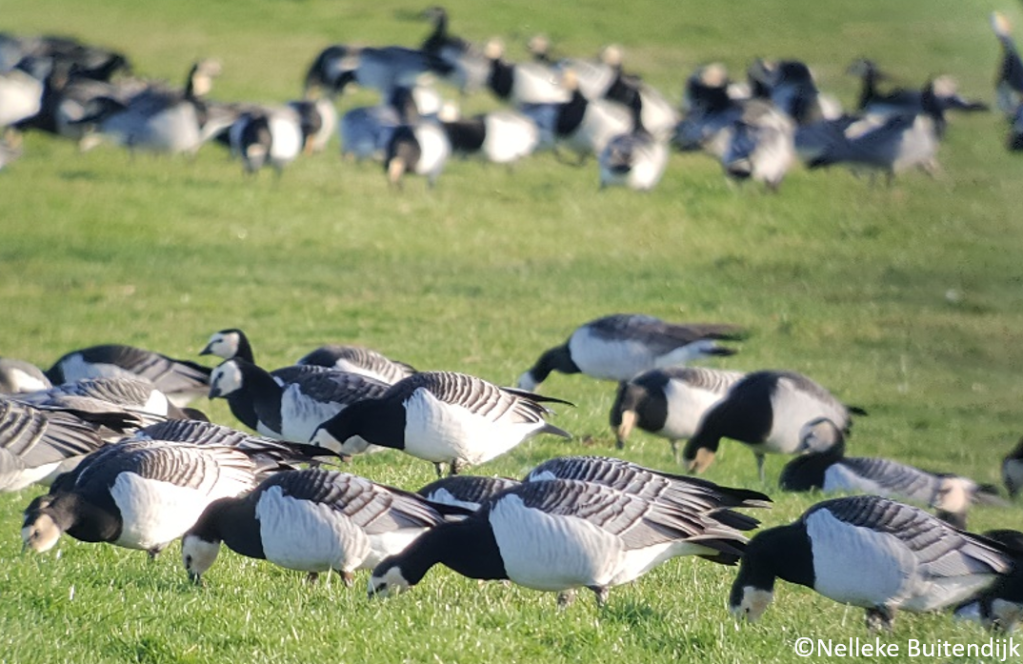This post is also available in Dutch here.
Nelleke Buitendijk discusses a newly published study from her and her colleagues on the impact of grazing on agricultural grasslands. Highlights include that decreasing herbivore abundance may not directly translate to a decreased yield loss, and that management tools should be used with care.
Grazing by geese can cause a lot of damage to agricultural crops. Goose management aims to reduce such damages, for example by actively reducing population sizes. An alternative approach is to chase geese away repeatedly in certain areas – encouraging them to move to dedicated agricultural land where they are left in peace (so-called accommodation areas).
However, many of the goose species that now occur in large numbers were threatened with extinction only a few decades ago, and are still protected as a result. Therefore, we need to be sure that a particular management approach will result in a decreased impact on agriculture before applying it – especially when the approach can have a negative effect on the species in question.
We looked at the relationship between assessed damages on agricultural grassland and the number of geese to help us understand how changing the number of geese in an area can affect yields. We included barnacle, white-fronted and greylag geese in our study, and focused on the first harvest in accommodation areas in Fryslân, the Netherlands. The Dutch Center for Field Ornithology (Sovon) provided detailed monthly goose counts, which we combined with tracking data from geese we equipped with GPS-transmitters. We received reports on assessed damages from BIJ12, who handle compensations for fauna damages in the Netherlands.
More geese may not always lead to more damage
Our study in Journal of Applied Ecology shows that yield loss is higher when there are more barnacle geese, but the two do not increase at an equal rate: for every extra barnacle goose added to a field, the subsequent extra damage is a little less. This means that concentrating geese in accommodation areas might result in lower overall yield losses, while population reduction may not be an effective tool to lower damages.
The relationship also depends on the presence of other goose species, with highest damages occurring when there are only barnacle geese on a field. In the region we studied, white-fronted and greylag geese have little effect on the assessed losses to spring harvests. This is likely because these species start their migration to the breeding grounds much earlier than barnacle geese and well before the time of first harvest.
Small and large goose species have different feeding preferences
We also see that large flocks of barnacle geese do not occur together with large numbers of white-fronted and greylag geese. This is likely because the species have different food preferences. Barnacle geese have a small bill, and can easily handle short grass, which is more difficult for the two larger species. However, the larger white-fronted and greylag geese have the benefit of a longer digestive tract, which helps to digest tough foods avoided by smaller species. This means that an area suitable for one goose species may be unattractive to another.

It may even be suggested that larger species are pushed out of areas where barnacle geese are abundant, because the grass has been grazed too short. A study in Norway also observed this, with larger pink-footed geese leaving areas where large numbers of barnacle geese had moved.
If these areas are too small to accommodate multiple goose species, large goose species may be forced out of safe accommodation areas. Subsequently, the larger species would suffer more from active scaring or derogation shooting (i.e. chasing geese away by shooting at them, under permit) outside of refuges, while potentially contributing less to agricultural yield loss.
Implications for management of wild herbivores
Our results show that we need to be careful when using management practices such as population reduction or active scaring. These practices can negatively affect the animals in question, while not necessarily reducing yield loss. It is also important to ensure that any management targets the right species; some species may affect yields much more than others. Finally, to make sure all species can find refuge, accommodation areas should represent feeding grounds of multiple species, and should be large enough to prevent competition between them.




